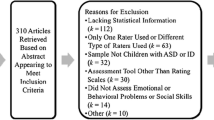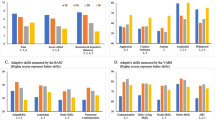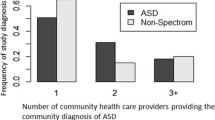Abstract
In children with autism spectrum disorder (ASD), there are often discrepancies between direct assessment and third-party reports. We compared these children with groups with/without difficulties in interpersonal problem-solving skills in order to determine whether these discrepancies appear and if they could be a diagnostic indicator for ASD. There were 91 participants (ages 7–13): 28 children with ASD, 36 in a high family risk situation, and 27 typically developing children, all tested with direct measures and third-party reports. Results showed discrepancies only in the ASD group. Consequently, direct performance measures and third-party reports seem to be evaluating different constructs in children with ASD. In addition, both types of measures discriminate between groups, such that both are needed, especially in diagnostic assessments.

Similar content being viewed by others
References
American Psychiatric Association (APA). (2013). Diagnostic and statistical manual of mental disorders, Fifth Edition (DSM-5). Arlington: American Psychiatric Publishing.
Bäckman, O., & Nilsson, A. (2011). Pathways to social exclusion—A life-course study. European Sociological Review, 27, 107–123. https://doi.org/10.1093/esr/jcp064.
Bal, E., Yerys, B. E., Sokoloff, J. L., Celano, M. J., Kenworthy, L., Giedd, J. N., & Wallace, G. L. (2013). Do social attribution skills improve with age in children with high functioning autism spectrum disorders? Research in Autism Spectrum Disorders, 7, 9–16. https://doi.org/10.1016/j.rasd.2012.07.004.
Bornstein, M. H., Hahn, C. S., & Haynes, O. M. (2010). Social competence, externalizing, and internalizing behavioral adjustment from early childhood through early adolescence: Developmental cascades. Development and Psychopathology, 22(4), 717–735.
Callenmark, B., Kjellin, L., Rönnqvist, L., & Bölte, S. (2014). Explicit versus implicit social cognition testing in autism spectrum disorder. Autism: The International Journal of Research and Practice, 18, 684–693. https://doi.org/10.1177/1362361313492393.
Cappadocia, M. C., & Weiss, J. A. (2011). Review of social skills training groups for youth with Asperger syndrome and high functioning autism. Research in Autism Spectrum Disorders, 5(1), 70–78.
Channon, S., Charman, T., Heap, J., Crawford, S., & Rios, P. (2001). Real-life-type problem-solving in Asperger’s syndrome. Journal of Autism and Developmental Disorders, 31, 461–469. https://doi.org/10.1023/A:1012212824307.
Calero, M. D., García-Martín, M. B., Molinero, C., & Bonete, S. (2009). Cuestionario de Evaluación de Solución de Conflictos Interpersonales, Cuestionario-ESCI [Assessment of Interpersonal Conflict Resolution Questionnaire]. Unpublished manuscript. University of Granada, Spain.
D’Zurilla, T. J., & Nezu, A. M. (2010). Problem-solving therapy. In K. S. Dobson (Ed.), Handbook of cognitive-behavioral therapies (pp. 197–225). New York: Guilford Press.
De Los Reyes, A. (2011). Introduction to the special section: More than measurement error: Discovering meaning behind informant discrepancies in clinical assessments of children and adolescents. Journal of Clinical Child & Adolescent Psychology, 40, 1–9. https://doi.org/10.1080/15374416.2011.533405.
De Los Reyes, A., Salas, S., Menzer, M. M., & Daruwala, S. E. (2013). Criterion validity of interpreting scores from multi-informant statistical interactions as measures of informant discrepancies in psychological assessments of children and adolescents. Psychological Assessment, 25, 509–519. https://doi.org/10.1037/a0032081.
De Los Reyes, A., Thomas, S. A., Goodman, K. L., & Kundey, S. M. A. (2013). Principles underlying the use of multiple informants’ reports. Annual Review of Clinical Psychology, 9, 123–149. https://doi.org/10.1146/annurev-clinpsy-050212-185617.
De Paúl, J., & Arruabarrena, M. I. (1999). Escalas de Bienestar Infantil de Magura y Moses. Un primer estudio para la validación de la versión española [Child well-being scales of Magura and Moses. A preliminary study for the validations of the Spanish version]. Intervención Psicosocial, 8, 89–107.
Delgado, J. P. (2017). Análisis de fiabilidad y validez interna del cuestionario de habilidades de interacción social de Monjas en una muestra de niños de 8 a 12 años [Analysis of reliability and internal validity of the Questionnaire on Social Interaction Skills of Monjas in a sample of children from 8 to 12 years old]. Unpublished master’s thesis, Pontificia Universidad Católica del Ecuador, Ecuador.
Devicienti, F., & Poggi, A. (2011). Poverty and social exclusion: Two sides of the same coin or dynamically interrelated processes? Applied Economics, 43(25), 3549–3571.
Downes, J. J., Roberts, A. C., Sahakian, B. J., Evenden, J. L., Morris, R. G., & Robbins, T. W. (1989). Impaired extra-dimensional shift performance in medicated and unmedicated Parkinson’s disease: Evidence for a specific attentional dysfunction. Neuropsychologia, 27, 1329–1343.
Enticott, P. G., Kennedy, H. A., Johnston, P. J., Rinehart, N. J., Tonge, B. J., Taffe, J. R., & Fitzgerald, P. B. (2014). Emotion recognition of static and dynamic faces in autism spectrum disorder. Cognition and Emotion, 28, 1110–1118. https://doi.org/10.1080/02699931.2013.867832.
Frith, C. D., & Frith, U. (2012). Mechanisms of social cognition. Annual Review of Psychology, 63, 287–313. https://doi.org/10.1146/annurev-psych-120710-100449.
Gómez-Pérez, M. M., Calero, M. D., Mata, S., & Molinero, C. (2016). Discrepancies between direct and indirect measures of interpersonal and neurocognitive skills in autism spectrum disorder children. Journal of Clinical and Experimental Neuropsychology, 38, 875–886. https://doi.org/10.1080/13803395.2016.1170106.
Gordon, M., & Cui, M. (2014). School-related parental involvement and adolescent academic achievement: The role of community poverty. Family Relations, 63(5), 616–626.
Greco, C., & Ison, M. S. (2011). Emociones positivas y solución de problemas interpersonales: Su importancia en el desarrollo de competencias sociales en la mediana infancia [Positive emotions and interpersonal problem solving: Importance in the social skills development in middle childhood]. Perspectivas en Psicología, 8, 20–29.
Hartley, A. G., Zakriski, A. L., & Wright, J. C. (2011). Probing the depths of informant discrepancies: Contextual influences on divergence and convergence. Journal of Clinical Child & Adolescent Psychology, 40, 54–66. https://doi.org/10.1080/15374416.2011.533404.
Heaton, R. K., Chelune, G. J., Talley, J. L., Kay, G. G., & Curtiss, G. (1993). Wisconsin card sorting test manual: Revised and extended. Odessa: Psychological Assessment Resources.
Hughes, C., Russell, J., & Robbins, T. W. (1994). Evidence for executive dysfunction in autism. Neuropsychologia, 32, 477–492.
Hunsley, J., & Mash, E. J. (2007). Evidence-based assessment. Annual Review of Clinical Psychology, 3, 29–51. https://doi.org/10.1146/annurev.clinpsy.3.022806.091419.
Johnson, S. A., Filliter, J. H., & Murphy, R. R. (2009). Discrepancies between self-and parent-perceptions of autistic traits and empathy in high functioning children and adolescents on the autism spectrum. Journal of Autism and Developmental Disorders, 39(12), 1706–1714.
Knott, F., Dunlop, A. W., & Mackay, T. (2006). Living with ASD: How do children and their parents assess their difficulties with social interaction and understanding? Autism, 10(6), 609–617.
Koenig, K., White, S. W., Pachler, M., Lau, M., Lewis, M., Klin, A., & Scahill, L. (2010). Promoting social skill development in children with pervasive developmental disorders: A feasibility and efficacy study. Journal of Autism and Developmental Disorders, 40, 1209–1218. https://doi.org/10.1007/s10803-010-0979-x.
Lerner, M. D., Calhoun, C. D., Mikami, A. Y., & De Los Reyes, A. (2012). Understanding parent-child social informant discrepancy in youth with high functioning autism spectrum disorders. Journal of Autism and Developmental Disorders, 42, 2680–2692. https://doi.org/10.1007/s10803-012-1525-9.
Lerner, M. D., & Mikami, A. Y. (2012). A preliminary randomized controlled trial of two social skills interventions for youth with high-functioning autism spectrum disorders. Focus on Autism and Other Developmental Disabilities, 27, 147–157.
Leshner, A. F., Tom, S. R., & Kern, R. S. (2013). Errorless learning and social problem solving ability in schizophrenia: An examination of the compensatory effects of training. Psychiatry Research, 206, 1–7. https://doi.org/10.1016/j.psychres.2012.10.007.
Lord, C., Rutter, M., DiLavore, P. C., & Risi, S. (2002). Escala de Observación de Diagnóstico de Autismo [Autism Diagnostic Observation Schedule, ADOS]. Madrid: TEA Ediciones.
Magura, S., & Moses, B. S. (1986). Outcome measures for Child Welfare Services. Washington, D.C.: Child Welfare League of America.
Martin, J. P., Stack, D. M., Serbin, L. A., Schwartzman, A. E., & Ledingham, J. (2012). Social problem solving in high-risk mother-child dyads: An intergenerational study. Social Development, 21, 47–67.
Mash, E. J., & Hunsley, J. (2005). Evidence-based assessment of child and adolescent disorders: Issues and challenges. Journal of Clinical Child and Adolescent Psychology, 34(3), 362–379.
Mata, S., Gómez-Pérez, M. M., Molinero, C., & Calero, M. D. (2017). Interpersonal problem-solving skills, executive function and learning potential in preadolescents with high/low family risk. The Spanish Journal of Psychology, 20, e56. https://doi.org/10.1017/sjp.2017.54.
Mathersul, D., McDonald, S., & Rushby, J. A. (2013). Understanding advanced theory of mind and empathy in high-functioning adults with autism spectrum disorder. Journal of Clinical and Experimental Neuropsychology, 35, 655–668. https://doi.org/10.1080/13803395.2013.809700.
Molinero, C. (2015). Análisis Psicométrico de la Prueba de Evaluación de Solución de Conflictos Interpersonales (ESCI) [Psychometric analysis of the Assessment of Interpersonal Conflict Solutions Test (ESCI)]. Unpublished doctoral dissertation, University of Granada, Spain.
Molinero, C., Bonete, S., Gómez-Pérez, M. M., & Calero, M. D. (2015). Estudio normativo del test de 60 caras de Ekman para adolescentes españoles [Normative study of Ekman 60 faces test for Spanish adolescents]. Behavioral Psychology, 23, 361–371.
Monjas, M. I. (2009). Programa de Enseñanza de Habilidades de Interacción Social para niños y niñas en edad escolar (PEHIS) [Skills Training Programme of Social Interaction for children of school age]. Madrid: CEPE.
Montgomery, J. M., Stoesz, B. M., & McCrimmon, A. W. (2013). Emotional intelligence, theory of mind, and executive functions as predictors of social outcomes in young adults with Asperger syndrome. Focus on Autism and Other Developmental Disabilities, 28, 4–13. https://doi.org/10.1177/1088357612461525.
Nah, Y. H., & Poon, K. K. (2011). The perception of social situations by children with autism spectrum disorders. Autism: The International Journal of Research and Practice, 15, 185–203. https://doi.org/10.1177/1362361309353616.
Poslawsky, I. E., Naber, F. B., Bakermans-Kranenburg, M. J., Van Daalen, E., Van Engeland, H., & Van Ijzendoorn, M. H. (2015). Video-feedback intervention to promote positive parenting adapted to autism (VIPP-AUTI): A randomized controlled trial. Autism: The International Journal of Research and Practice, 19, 588–603. https://doi.org/10.1177/1362361314537124.
Rutter, M., LeCouteur, A., & Lord, C. (2000). Entrevista Diagnóstica del Autismo-Revisada [Autism Diagnostic Interview-Revised, ADI-R]. Madrid: TEA Ediciones.
Sarsour, K., Sheridan, M., Jutte, D., Nuru-Jeter, A., Hinshaw, S., & Boyce, W. T. (2011). Family socioeconomic status and child executive functions: The roles of language, home environment, and single parenthood. Journal of the International Neuropsychological Society, 17, 120–132. https://doi.org/10.1017/S1355617710001335.
Sawyer, A. C. P., Williamson, P., & Young, R. (2014). Metacognitive processes in emotion recognition: Are they different in adults with Asperger’s disorder? Journal of Autism and Developmental Disorders, 44, 1373–1382. https://doi.org/10.1007/s10803-013-1999-0.
Schneider, D., Slaughter, V. P., Bayliss, A. P., & Dux, P. E. (2013). A temporally sustained implicit theory of mind deficit in autism spectrum disorders. Cognition: International Journal of Cognitive Science, 129, 410–417. https://doi.org/10.1016/j.cognition.2013.08.004.
Schuwerk, T., Vuori, M., & Sodian, B. (2015). Implicit and explicit theory of mind reasoning in autism spectrum disorders: The impact of experience. Autism: The International Journal of Research and Practice, 19, 459–468. https://doi.org/10.1177/1362361314526004.
Senju, A. (2012). Spontaneous theory of mind and its absence in autism spectrum disorders. The Neuroscientist, 18, 108–113. https://doi.org/10.1177/1073858410397208.
Senju, A. (2013). Atypical development of spontaneous social cognition in autism spectrum disorders. Brain and Development, 35, 96–101. https://doi.org/10.1016/j.braindev.2012.08.002.
Sheldrick, R. C., Neger, E. N., Shipman, D., & Perrin, E. C. (2012). Quality of life of adolescents with autism spectrum disorders: Concordance among adolescents’ self-reports, parents’ reports, and parents’ proxy reports. Quality of Life Research, 21(1), 53–57.
Teunisse, J. P., Roelofs, R. L., Verhoeven, E. W. M., Cuppen, L., Mol, J., & Berger, H. J. C. (2012). Flexibility in children with autism spectrum disorders (ASD): Inconsistency between neuropsychological tests and parent-based rating scales. Journal of Clinical and Experimental Neuropsychology, 34, 714–723. https://doi.org/10.1080/13803395.2012.670209.
Wan, M. W., Green, J., Elsabbagh, M., Johnson, M., Charman, T., Plummer, F., & Basis Team (2013). Quality of interaction between at-risk infants and caregiver at 12–15 months is associated with 3-year autism outcome. Journal of Child Psychology and Psychiatry, 54(7), 763–771.
Waugh, C., & Peskin, J. (2015). Improving the social skills of children with HFASD: An intervention study. Journal of Autism and Developmental Disorders, 45, 2961–2980. https://doi.org/10.1007/s10803-015-2459-9.
Wechsler, D. (2005). Escala de inteligencia de Wechsler para niños-IV (WISC-IV) [Wechsler intelligence scale for children—IV]. Madrid: TEA Ediciones.
Whittaker, J. E. V., Harden, B. J., See, H. M., Meisch, A. D., & T’Pring, R. W. (2011). Family risks and protective factors: Pathways to Early Head Start toddlers’ social–emotional functioning. Early Childhood Research Quarterly, 26(1), 74–86.
Yoshikawa, H., Aber, J. L., & Beradslee, W. R. (2012). The effects of poverty on the mental, emotional, and behavioral health of children and youth implications for prevention. American Psychologist, 67, 272–284. https://doi.org/10.1037/a0028015.
Young, A. W., Perrett, D., Calder, A., Sprengelmeyr, R., & Ekman, P. (2002). Facial expressions of emotions: Stimuli and test. San Antonio: Harcourt Assessment.
Young, J. C., & Widom, C. S. (2014). Long-term effects of child abuse and neglect on emotion processing in adulthood. Child Abuse & Neglect, 38, 1369–1381.
Acknowledgments
We are grateful to the participants, their parents and staff from the associations and schools involved.
Funding
This research was supported by the Spanish Ministry of Science and Innovation, R&D Project Ref. 2011-24370 and by the Andalusian Regional Government (Junta de Andalucía) through Proyecto de Excelencia convocatoria 2012, Ref. P12-SEJ-560.
Author information
Authors and Affiliations
Contributions
MMG contributed to the study desing, collected data, analysed data and wrote the manuscript. SM contributed to the study design, collected data, analysed data and wrote the manuscript. MDC contributed to the study design, analysed data and wrote the manuscript.
Corresponding author
Ethics declarations
Conflict of interest
The authors declare that there is no conflict of interest.
Ethical Approval
All procedures performed in studies involving human participants were in accordance with the ethical standards of the institutional and/or national research committee and with the 1964 Helsinki declaration and its later amendments or comparable ethical standards.
Informed Consent
Informed consent was obtained from all participants’ parents included in the study.
Additional information
Publisher’s Note
Springer Nature remains neutral with regard to jurisdictional claims in published maps and institutional affiliations.
Rights and permissions
About this article
Cite this article
Gómez-Pérez, M.M., Mata, S. & Calero, M.D. Discrepancies When Assessing Interpersonal Problem-Solving Skills in Autism Spectrum Disorder: A Diagnostic Indicator. J Autism Dev Disord 49, 1505–1516 (2019). https://doi.org/10.1007/s10803-018-3852-y
Published:
Issue Date:
DOI: https://doi.org/10.1007/s10803-018-3852-y




